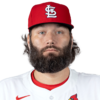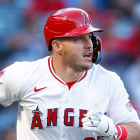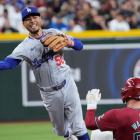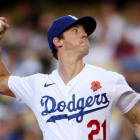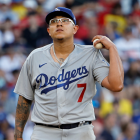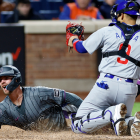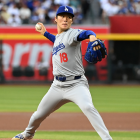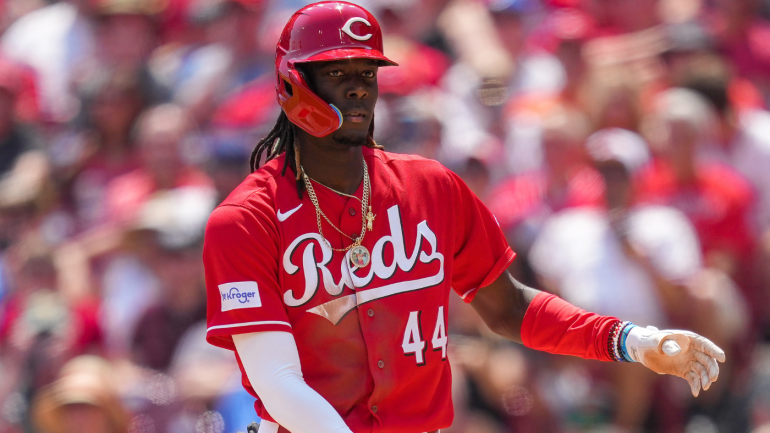
The 2023 MLB All-Star Game is in the rearview mirror and the trade deadline is less than one week away. Pretty soon there will be a bunch of new faces in new places, and the dog days of August will arrive. Soon after that the division and postseason races will kick it into high gear. Still plenty to be decided with two months to play.
Our bi-weekly series breaking down various trends across the league continues Wednesday with a look at how one young player can get to the next level, one contender's looming rotation problem, and an under-the-radar trade target. Three weeks ago, we examined the way two stars are getting better, and Miami's sneaky-good bullpen (until lately, anyway).
How De La Cruz can get to the next level
In his seven weeks as a big leaguer, Reds wunderkind Elly De La Cruz has proven to be one of the most exciting talents and best young players in baseball. Already we've seen him crush titanic home runs, hit for the cycle, and steal second, third, and home in one trip around the bases (on only two pitches!). You can't take your eyes off Cruz. He's electrifying.
Baseball is a cruel game, of course, and opposing teams have already figured out a way to attack De La Cruz. He's seeing fewer fastballs and is in a 4-for-44 (.091) slump since the All-Star break. Granted, two of his four hits are home runs, including one that cleared the truck at American Family Field, but he's also struck out 19 times in those 44 at-bats.
Growing pains and adjustment periods come with the territory with young players and it was inevitable De La Cruz would hit a bump in the road at some point. The raw tools and natural gifts -- the power, the speed, the arm -- are obvious. The next step for De La Cruz is learning how to elevate the ball more often, and get the most out of that natural power.
Here are the highest ground ball rates in baseball entering Tuesday's games (min. 150 plate appearances):
- Tim Anderson, White Sox: 64.1% (😬)
- Nick Madrigal, Cubs: 60.4%
- Jean Segura, Marlins: 57.5%
- Elly De La Cruz, Reds: 57.3%
- Gabriel Moreno, Diamondbacks: 56.6%
The next few names on that leaderboard are guys like Ji-Hwan Bae, Nicky Lopez, and Raimel Tapia. Not a group you want to be in, offensively. De La Cruz hits the ball very hard and gets more out of his grounders than those guys, but the fact is he hits a lot of ground balls, and ground balls mute offensive output because they don't go for extra bases often and don't go over the fence ever.
The good news is De La Cruz has shown some progress elevating the ball. Not a ton, but his ground ball rate has been ever so slightly trending down in recent weeks. Here's his ground ball rate, and also the rate of four-seam fastballs he's seen, just so you can see how opposing pitchers have challenged him less and less as the season has progressed:
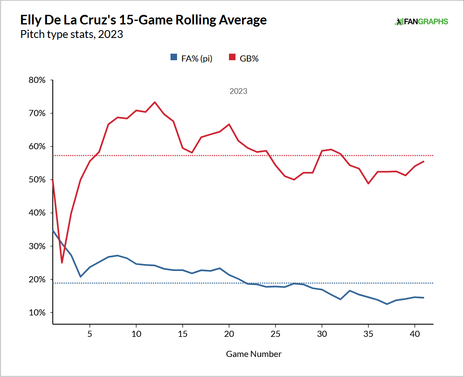
A high ground ball rate isn't a fatal flaw. It's just something De La Cruz can improve, and when he does learn how to elevate the ball more, he'll become a monster because he hits the ball so dang hard. It's really difficult to put a ceiling on this kid because he's so gifted. He reminds me of Fernando Tatis Jr. in that regard. De La Cruz looks like he can do anything on the field.
Like every young player, De La Cruz is still learning and developing, and getting the ball airborne is one way to unlock another level of performance. And keep in mind, he has already shown the ability to make adjustments in his pro career. He's a different player now than he was a few years ago in the minors. When it comes to cutting down on ground balls, I won't bet against him. De La Cruz will figure it out in time.
Baltimore's looming rotation problem
Now that they're in first place and near lock to make the postseason, expect the Orioles to add at the deadline. How aggressively will they add? I'm not sure. GM Mike Elias is a bit cagey and continues to preach the long-term vision, but the players have put themselves in position to be reinforced at the deadline. It's time. The rebuild is over.
The O's brought in Shintaro Fujinami last week and figure to seek a starting pitcher prior to the deadline. The ideal addition would be someone under contract or team control behind 2023 like, say, Dylan Cease or Jesús Luzardo. Absent that, Baltimore will have to stick to rentals, and there's nothing wrong with rentals. They can be very helpful too.
Baltimore's starters rank 16th with a 4.49 ERA and 19th with 5.5 WAR, so firmly middle of the pack. There is clearly room to improve. Also, the young pitchers are rapidly approaching their previous career high in innings. They don't want these guys getting fatigued and hitting a wall in mid-August, you know?
Incredibly, the Orioles have used only seven different starting pitchers this year -- only the Blue Jays and Nationals (six each) have used fewer starters -- and one of the seven, Keegan Akin, made just one spot start as part of a bullpen game. Here are the workloads of the team's six regular starters (innings totals include minor leagues, postseason, etc.):
| Age | 2023 innings | 2022 innings | Career high innings | |
|---|---|---|---|---|
RHP Kyle Gibson | 32 | 127 | 182 | 196 2/3 in 2018 |
RHP Dean Kremer | 27 | 115 2/3 | 134 1/3 | 134 1/3 in 2022 |
RHP Tyler Wells | 28 | 111 | 106 | 119 1/3 in 2018 |
RHP Kyle Bradish | 26 | 102 1/3 | 145 1/3 | 145 1/3 in 2022 |
23 | 97 1/3 | 75 2/3 | 103 in 2021 | |
LHP Cole Irvin | 29 | 83 2/3 | 186 | 186 in 2022 |
The O's don't have to worry about Gibson, the veteran leader who has been chewing up innings since his first full big-league season in 2014. Irvin will be fine as well; he's thrown over 150 innings in a season several times. I would imagine Irvin, who has bounced between MLB and Triple-A, and between the rotation and the bullpen, will get starts down the stretch just to lighten the load on everyone else.
The kids -- Bradish, Kremer, Rodriguez, Wells -- are all nearing their previous career-high innings totals. Another few starts (or even just one start in Rodriguez's case) and they're there. And throwing 120 innings in the big leagues is much different than throwing 120 innings in the minors. They're more intense, more challenging, and more taxing.
Irvin should be able to soak up innings down the stretch and John Means, Baltimore's best starter through the rebuild, could return from Tommy John surgery before the end of the season. He threw a bullpen session soon after the All-Star break and, if all goes well, could return in late August or September. Not sure the O's should rely on Means, but he might be able to help.
The Orioles are in a tricky spot. They want to win the division and secure a Wild Card Series bye, and make a deep postseason run. To do that, they'll need guys like Bradlish and Kremer and Rodriguez and Wells. The O's also must monitor their workloads though. What good are they in October if they're running on fumes and fatigue compromises their effectiveness?
I should note the workload concerns are not limited to the rotation. All-Star setup man Yennier Cano is up to 53 2/3 innings this year and he hasn't thrown as many as 70 innings in a season since 2015, when he was still pitching in Cuba. The Orioles brought in Fujinami to give Cano some help in the late innings. Now they need to get their young starters help to avoid overworking them.
Three reasons Lynn is an attractive trade target
Even in the weak AL Central, the White Sox have played themselves so far out of the race that they have no choice but to sell at the deadline. Core players under contract/team control beyond 2023, like Eloy Jiménez and Luis Robert Jr., aren't going anywhere. Rentals like Lucas Giolito, Yasmani Grandal, and Lance Lynn should already have their bags packed though.
Lynn, 36, leads baseball in earned runs (79) and home runs (28) allowed. He's been hideous. That said, he is still a workhorse, and innings are in short supply around the league. Squint your eyes and you can also see reasons to believe Lynn can be better moving forward, particularly away from a toxic losing atmosphere like the one on Chicago's South Side.
1. His curveball is back. Lynn changed his pitch mix last month, most notably scaling back on his four-seam fastball -- opponents are slugging .543 against his four-seamer this year -- and bringing back his curveball, a pitch he used infrequently in previous years and not at all this year prior to June 13. In his second start with the curveball, Lynn struck out 16 Mariners in seven innings.
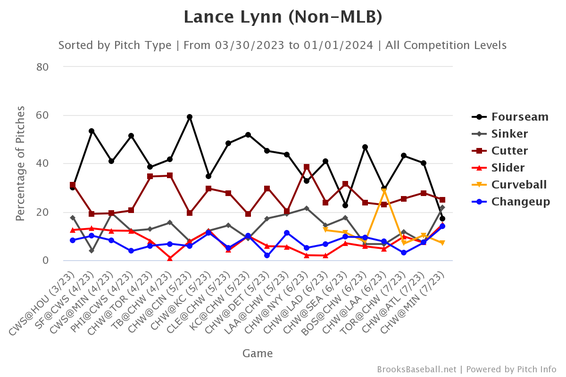
Lynn has been hit hard in his last two starts (13 runs in 12 innings), though his strikeout rate has jumped from 24.3% earlier this year to 32.6% since bringing back his curveball. A smart team with a knack for optimizing pitchers could further tweak Lynn's pitch usage and get his ERA to align more closely with his excellent strikeout rate.
2. He needs a better defense. Even with Robert providing Gold Glove defense in center, the White Sox are a dreadful defensive team. Their minus-42 defensive runs saved are second worst in baseball, better than only the bad-on-purpose Athletics, and their outfield is at minus-5 DRS even with Robert being a plus-6 DRS center fielder. Robert is only one man. He can't do it all out there.
According to Statcast, Chicago's defense has put up minus-4 outs above average when Lynn is on the mound this season, one of the worst marks in baseball. He's a fly ball pitcher -- Lynn's 37.8% ground ball rate is 14th lowest among qualified starters -- who pitches in front of a poor defensive outfield even with Robert. With a competent defense, Lynn's numbers would theoretically be much better.
3. His home run rate isn't sustainable. I think? Maybe it is. Outfield defense doesn't matter when the ball sails out of the park and Lynn has allowed an MLB-worst 28 homers this year. His home run-to-fly ball rate is an astronomical 21.5%. The league average is 12.5% and Lynn easily has the highest rate in the league. He can't keep that up all season. Can he?
Reliable batted ball data goes back to 2002. Ignoring the 2020 pandemic season, only seven pitchers posted a 20.0% HR/FB rate while throwing enough innings to qualifying for the ERA title from 2002-22. That's out of 1,545 individual qualified pitcher seasons:
- Yu Darvish, 2019 Cubs: 22.8%
- Patrick Corbin, 2021 Nationals: 22.6%
- Masahiro Tanaka, 2017 Yankees: 21.2%
- Max Fried, 2019 Braves: 20.2%
- Jaime García, 2016 Cardinals: 20.2%
- Germán Márquez, 2019 Rockies: 20.1%
- Robbie Ray, 2019 Diamondbacks: 20.0%
One of those seven seasons happened to a Coors Field pitcher and four of the seven happened in 2019, the Year of the Home Run. Maybe 2023 Lance Lynn really is one of the most home run prone pitchers of the last 20 years. It's possible. It's also possible he'll pitch closer to his career 11.0% HR/FB rate (11.8% from 2021-22) the rest of the year and keep the ball in the park more.
Guaranteed Rate Field is one of the most home run happy ballparks in the majors -- it has inflated homers to 11% of the league average the last three years, per Statcast -- so get Lynn into a home park that's a little more neutral (or pitcher-friendly even), and there's reason to believe he'll rein in the home runs a bit. Even getting down to a 15.0% HR/FB rate would be a huge improvement.
The ideal fit for Lynn is a team with a knack for optimizing pitch usage, a good outfield defense, and a home ballpark that doesn't inflate home runs. The Dodgers and Rays immediately jump to mind, though Dodger Stadium is more homer happy than you might suspect. Those two clubs know how to get the most out of pitchers and they have above-average outfield defenses, statistically.
Lynn has roughly $7 million remaining on his contract and he has a 10-team no-trade clause, so a few obstacles would have to be cleared, but he's a better trade target than his unsightly 6.18 ERA would lead you to believe. If nothing else, Lynn can provide his next team with innings and a lot of them. He's better than a lot of No. 5 starters out there right now.











